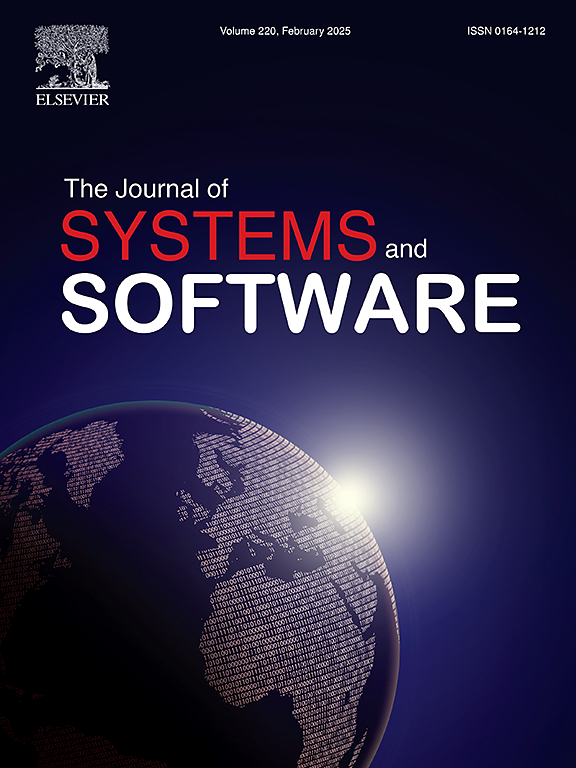Retriever: A view-based approach to reverse engineering software architecture models
IF 3.7
2区 计算机科学
Q1 COMPUTER SCIENCE, SOFTWARE ENGINEERING
引用次数: 0
Abstract
Software systems, which have become an integral part of our daily lives, are constantly evolving and growing in complexity. The challenge of understanding and managing these systems has led to a shift towards automated extraction of models from software artifacts. However, extracting architectural models for web service or microservice systems is challenging due to the heterogeneity of formats, languages, and semantics. This challenge arises from the independent deployment and loose coupling of services, as well as the diverse technologies and platforms that comprise the heterogeneous artifacts. This paper addresses this issue with two key ideas: a knowledge representation model for diverse artifacts and a framework for integrating individual views into a unified architectural model. The former involves model-to-model transformations that consider technology-specific relationships and concepts. At the same time, the latter uses model transformation and composition techniques to create a unified model based on an existing metamodel. This work goes beyond the current state of the art by introducing an approach for reconstructing component-based software architectures and combining model-driven reverse engineering processes to capture information across multiple views. As empirical evidence of its applicability and accuracy, we report on its successful application in real projects of different sizes. Our evaluation shows scalability in generating architectural models and can reconstruct the components of a software system and their interactions with values up to 0.94 for structural properties and up to 0.88 for behavioral properties.
Retriever:基于视图的软件架构模型逆向工程方法
软件系统已成为我们日常生活中不可或缺的一部分,其复杂性在不断发展和增长。理解和管理这些系统所面临的挑战促使人们转向从软件工件中自动提取模型。然而,由于格式、语言和语义的异质性,提取网络服务或微服务系统的架构模型具有挑战性。这一挑战源于服务的独立部署和松散耦合,以及构成异构人工制品的各种技术和平台。本文提出了两个主要观点来解决这个问题:一个是适用于不同人工制品的知识表示模型,另一个是将各个视图集成到统一架构模型中的框架。前者涉及考虑特定技术关系和概念的模型到模型转换。同时,后者使用模型转换和组合技术,在现有元模型的基础上创建统一模型。这项工作超越了当前的技术水平,引入了一种重构基于组件的软件架构的方法,并结合了模型驱动的逆向工程流程,以获取跨多个视图的信息。作为其适用性和准确性的经验证据,我们报告了其在不同规模的实际项目中的成功应用。我们的评估结果表明了生成架构模型的可扩展性,并能重建软件系统的组件及其交互,其结构属性的 F1 值高达 0.94,行为属性的 F1 值高达 0.88。
本文章由计算机程序翻译,如有差异,请以英文原文为准。
求助全文
约1分钟内获得全文
求助全文
来源期刊

Journal of Systems and Software
工程技术-计算机:理论方法
CiteScore
8.60
自引率
5.70%
发文量
193
审稿时长
16 weeks
期刊介绍:
The Journal of Systems and Software publishes papers covering all aspects of software engineering and related hardware-software-systems issues. All articles should include a validation of the idea presented, e.g. through case studies, experiments, or systematic comparisons with other approaches already in practice. Topics of interest include, but are not limited to:
•Methods and tools for, and empirical studies on, software requirements, design, architecture, verification and validation, maintenance and evolution
•Agile, model-driven, service-oriented, open source and global software development
•Approaches for mobile, multiprocessing, real-time, distributed, cloud-based, dependable and virtualized systems
•Human factors and management concerns of software development
•Data management and big data issues of software systems
•Metrics and evaluation, data mining of software development resources
•Business and economic aspects of software development processes
The journal welcomes state-of-the-art surveys and reports of practical experience for all of these topics.
 求助内容:
求助内容: 应助结果提醒方式:
应助结果提醒方式:


